I've heard SID referred to as sensory processing disorder. However, for this post I'm going to refer to it as SID since what I wrote below refers to it as such.
Even at 9 1/2 year old - four years after I wrote the article for the newsletter - SID can cause Olivia to have meltdowns. One of the most effective ways for calming is laying down under multiple layers of blankets in a dark or semi-dark room. Even at night, Olivia will sleep under about a dozen blankets and quilts. Literally. It's not that the house is cold...she just finds the weight of the blankets and quilts calming.
One of the things that I have wanted to get to help her when she has meltdowns is a weighted blanket. However, they are quite cost-prohibitive. As I was looking for an example of a weighted blanket, I came across a tutorial for a weighted blanket. Eight years ago, when SID was the most challenging, I couldn't find anything like this - now I can go ahead and make one for her.
Below is an article I wrote that provides some background about SID and Olivia's struggle with it. Although it focuses on Olivia, Sophia also has SID. Her issues within SID are somewhat different than Olivia's and not as severe, but there are some "triggers" that are similar for both of them.
Both the girls underwent an intensive therapy program at Special Children Center which was pivotal to seeing a vast improvement in so many different ways.
In sharing this, I'm hoping that it is helpful to parents who might see some of the same behavior and reactions with their children, and need some ideas about what to do to help calm a child.
*~*~*~*~*~*
“Olivia is propped up on three sides with pillows to help her sit up, and to cushion her when she falls. For some reason, at ten months, Olivia isn’t able to hold her head up on her own, falls over a lot while sitting, and has a vacant – almost sad – look in her eyes.”
(Noted November 21, 2003…four days after adopting Olivia from Dianjiang Social Welfare Institute in China.)
It took four days after adopting Olivia on November 17, 2003, to acknowledge to my family and friends that Olivia was different than who I imagined she would be.
Olivia's referral picture.
(Taken in 2003.)
I pictured a healthy, bubbly, laughing daughter – one who was eager to meet her forever family; and would have a few days (maximum) dealing with grieving issues. Sophia’s (Olivia’s sister) adoption went so smoothly two years earlier, so I anticipated a similar “easy” experience. Olivia’s referral pictures and medical form indicated this could be expected.
In reality, my expectations were vastly different from the actual experience in China as well as to the present day.
“Olivia has significant development delays, and needs further testing…” (International Adoption Clinic Report, December 2003)
I reread that sentence a few times when I received the report. The entire report from the International Adoption Clinic at the University of Minnesota was quite sobering. There were many challenges and issues I simply wasn’t prepared for or could comprehend what the lifelong impact was for Olivia.
Although it was sad to read the report, at least I knew that Olivia needed special care and therapy to help address her developmental delays.
The Next Step
I contacted Washington County’s Early Intervention Network for a free evaluation of Olivia. At the appointment in February 2004, Olivia met with a special education therapist, occupational therapist, and physical therapist, it was very clear that she was significantly behind children her age.
In most skills – physical; fine and gross motor; communication and language; and cognitive – she easily qualified for services. Olivia was 14 months old and operating at a 6-8 month level.
In March 2004, weekly therapy sessions with an occupational therapist, special education therapist, and physical therapist began. During some weeks, Olivia had one session…other weeks she had up to three therapy sessions.
Continued Challenges
Despite great progress with OT, PT, and Special Education, there was still something that didn’t “sit right” with me.
There were some troubling behaviors during the next year. For example, Olivia:
- Did not want to walk on grass and uneven surfaces. The majority of time she would take 2-3 steps, and simply collapse into a pile and sob and scream.
Success! Five years later,
Olivia enjoys going on walks with the dogs.
(Taken on May 17, 2009.)
- Unleashed what can only be described as blood-curdling screams when placed in a bathtub for a bath and to have her hair washed.
- Stuffed her mouth full of certain types of food and often choked on them.
- Screamed and kicked while I washed her face, cleaned under her nose, cut her fingernails, or changed her diaper.
- Pointed constantly to ceiling fans and lights…and was almost pulled into a lull by them.
- Was drawn into a world of her own, and didn’t hear and/or respond when her name was called.
- Had an extremely limited diet because she couldn’t tolerate certain textures or food temperatures.
Macaroni and cheese was one of the few types of food Olivia would eat.
It couldn't be homemade like this kind I made.
It had to be the kind out of a box.
- Hit and clawed me while screaming as I tried to hold her kicking legs down while brushing her teeth.
- Wanted to ride on the lawn tractor (despite the noise and the bumps) yet wasn’t able to tolerate voices that were in a normal conversational tone.
- Tripped frequently over legs, dog tails, and toys that were in plain view. She had very poor balance and seemed almost clumsy.
Montague and Gretel resting.
Olivia would trip frequently over them
prior to going through therapy for SI issues.
(Taken on April 11, 2008.)
- Yelled “Ow! Ow” and sobbed with each stroke as I brushed her hair gently…and, on a good day, managed to get it into pigtails or a ponytail so her hair would stay out of her eyes.
One of rare times I was able to get Olivia's hair pulled up.
This was taken at the Fourth of July parade.
She was 6 years old.
(Taken on July 4, 2009)
When I was at home and no one was witnessing her difficult behavior, I was okay. I could deal with it, but it certainly was frustrating, confusing, and overwhelming. It often made no sense; and, without Olivia’s ability to communicate, often times I didn’t know the triggers that were setting off her tantrums.
It was when I was in public and couldn’t calm Olivia that I was very embarrassed, and began to question my ability as a parent.
Change in Therapist…A New Perspective
The EIN OT who had been working with Olivia went on maternity leave. She was replaced by a new therapist who believes that all children – to some degree – have challenges with Sensory Integration Dysfunction (SID), and until those challenges are addressed, a child cannot master the skills with which they are struggling.
Sensory Integration (SID) is, simply put, the ability to take in information through one’s senses (e.g., touch, movement, smell, taste, vision, hearing); put it together with prior information, memories, and knowledge stored in the brain; and make a meaningful response.
When a child has a dysfunction with SI, the central nervous system and mid-brain are not interacting properly. Thus, a number of areas are affected: coordination, attention, arousal levels, autonomic functioning, emotions, memory, and higher-level cognitive functions.
An analogy for SI could be: imagine that you are on a plane. You’re hot, the lights hurt your eyes, people are talking loudly around you, the person in front of you has bad body odor, and the food you are attempting to eat is runny and cold…and it’s not supposed to be like that. You’re obviously trapped and this is one of the most miserable situations you’ve been in. Now multiple that experience by 100 and you get a sense of what a child with SI deals with on a daily basis.
Given the complexity of the various areas that are dependent upon and interact with each other, the OT met with Olivia for a few sessions before she recommended I complete a survey that could assess if Olivia had SI deficits. After “scoring” the answers, the OT said, “Olivia has significant sensory integration issues.”
Adopted at 10 months old, Olivia still fit into the clothes
she wore on her adoption day when she was 4 years old.
The pants and sleeves were a bit short,
but she was pretty excited that she could still fit in them.
(Taken on August 9, 2007.)
Some people may not want their child to be “labeled.” For me, however, a “label” was (and is) extraordinarily helpful. I have a name for what Olivia struggles with each day. I can look for books, therapy, and information on the internet to help understand and address Olivia’s SI.
I could change the home to make it more calming for Olivia, and make adaptive items to help her learn new skills and ways to manage SI on a daily basis.
Changes in Olivia as Progress is Made
Once SI was identified as being the root cause for other developmental delays, Olivia’s progressed at an even greater rate. She was becoming closer to her peers in terms of the skills she was learning and acquiring.
One of the ideas for children who have SI issues
is to using long straws.
The girls thought they were fun to use
(they came in different color segments and
they could create their straws).
In reality, they also had therapeutic benefits.
(Taken on December 25, 2007)
After a one-year review, PT was reduced to once a quarter, OT to bi-weekly, and Special Education to bi-weekly. Still, Olivia was significantly delayed in speech and communication. This was becoming a concern even though she was communicating both in American Sign Language (ASL) and a few single words. The former was the more dominant way of communication, with her signs substantially outnumbering her words.
Therapeutic Horseback Riding
Olivia began therapeutic horseback riding sessions in Summer 2005 through the Courage Riders (a program through the Courage Center in Stillwater). During the weekly one-hour session, Olivia - who was 2 1/2 years old at the time - received a wide range of therapeutic benefits.
Olivia during one of the therapeutic horseback riding sessions.
(Taken in October 2008 when Olivia was 5 years old.)
From “simple” activities for just one hour – such as grooming “her” horse and then riding on her around the ring or going on a trail ride – Olivia gained more physical strength in her lower body and began using more verbal skills.
Olivia feeding a treat to the horse
during the Courage Riders program.
The other people are volunteers and the horse's owner.
(Taken on August 28, 2008 when she was 5 years old.)
She began putting two words together during the Courage Riders program. “Okay, Mama,” were the first two words she put together. I cried. It was such a milestone for her. And I was so proud of her!
In Hindsight
Here are some ideas for others who may suspect their child may have SI:
- Note in a journal any behavior that seems unusual or doesn’t “feel right.” Include the date, time, and what precipitated it. At the one-month review with your social worker, share your observations.
- If there’s any indication of SI, begin therapy immediately. Both child and parent benefit by working on your child’s SI needs. Find therapists right away who can develop a sensory diet for your child to help her manage her SI.
- Realize that SI isn’t a reflection of one’s parenting skills. SI is something within a child that needs to be addressed, and you’ve been gifted with the skills to research and find out ways to help your child overcome the challenges she experiences each day with SI.
- Be ready for a change in direction in your life. Therapy for SI is intense and requires daily effort. Would it be easier to ignore it? Sure, in some ways. But ultimately you would be doing your daughter a disservice, and perhaps limiting her for the rest of her life. Your relationship with your daughter will deepen if you both work daily as a team to address SI issues.
Sophia and Olivia both enjoyed playing in
the soybean pit. It provided great sensory input.
(Taken on September 18, 2010.)
- Make the time to create some of the items in The Out Of Sync Child Has Fun. Having a wide repertoire of supplies and materials to draw from to help a child with SI is very helpful.
The girls would go into the body sack that I made for them.
The fabric would stretch and
provide the feedback their bodies needed.
(Taken in May 2008 when the girls were 5 and 7 years old.)
- Take care of yourself. Seek support from family and friends as well as community resources. Arrange respite care at least once a week, if possible.
Closing Thoughts
Now, almost two years after Olivia’s adoption, she is a very different child from who she was then. Her therapy sessions in OT, Special Education, and PT give her one-on-one time with talented and caring specialists who have helped her reach levels she couldn’t have reached on her own.
Her personality has blossomed into one filled with laughs, smiles, a sense of humor, full of expression, goofiness, and a sense of determination. Her tantrums – which were multiple daily…sometimes 5-6 per day - are almost non-existent.
Is Olivia “cured?” No. Her journey has only begun. Next month, she will be evaluated at the Special Children Center in Hudson, Wisconsin, to determine what level her SI needs are at, and to design a sensory diet that will address her needs. She will continue learning American Sign Language along with trying to build her verbal skills to reach peer level. Olivia will continue weekly therapy sessions as well as therapeutic horseback riding.
Parenting a child with SI is very different than I imagined doing. It’s meant some major life changes I’ve chosen to make to better address Olivia’s needs on a daily basis. Today I’m a stay-at-home mom who is home-schooling Olivia and Sophia. Although my life is radically different than I pictured it even a few years, I couldn’t be happier and feel more blessed.
Helpful Resources
Books:
Sensory Integration and the Child, A. Jean Ayres, Ph.D.
The Out of Sync Child, Carol Stock Kranow.
The Out of Sync Child Has Fun, Carol Stock Kranow.
Books from the Early Sign Language series (see www.garlicpress.com or local bookstores).
Community Organizations
- Courage Center and its Courage Riders Program (Stillwater)
Olivia doing exercises while riding on a horse
during the Courage Riders program.
(Taken on August 24, 2010.)
- Early Intervention Network (through any school district)
- Family Means and its Respite Care Program (Stillwater)
- Special Children Center in Hudson (WI)







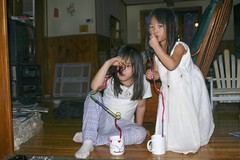
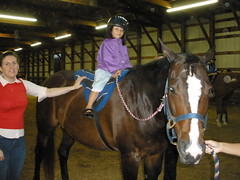
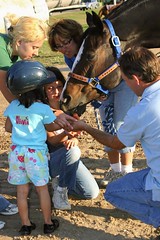
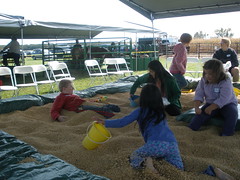
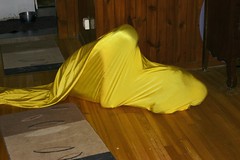


7 comments:
I'm glad Olivia is doing so well. This is a very interesting post and I know it will be helpful to many of your readers.
This is absolutely amazing!! ♥ My daughter was diagnosed with Sensory Processing Disorder when she was 18 months old. She is now 7 and (mostly) functions on a normal level. It's surreal how a child changes your views and the tips/tricks associated with an ASD become 'normal' to us, isn't it? I now have a (so far) non-SPD toddler, and I find myself overwhelmed that he takes baths and wears clothes with tags without injuring either of us. lol. Such a beautiful journey for you and Olivia!
What a great mom you are by really trying to understand the issues that Olivia has! I've seen so many parents with special needs children that don't really take the time to understand what really triggers the emotions.
What a wonderful post about SI. Your post was very informative. I love how you took the time to understand your children. Many parents would become very frustrated with a lot of these behaviors.
Very informative. My daughter has anxiety issues. It not the same of course to what your going thru, but in having a fear of trying anything new or different the tantrums and fear is something I can simply relate to.
I love the idea of the weighted blanket too. Another idea, if you didn't already know about it is using a military wool blanket.
The real ones, are really heavy {I'd place it at least 5pds} and quite scratchy. So my grandmother simply stitched her version up inside a quilt that had a velvet like cover so the blanket seems to grab you even and not slide off. It is still my utter favorite, and so heavy you can barely move under it. But it drapes to hug your body too. My Husband served in the Marines too but we place ours inside a duvet cover but it does move more without being anchored. One day I'll quilt mine as well.
In any case...it might be something to help as well. :-D
This is fantastic. I've had several children in my classrooms with SID, and it can be a struggle before you learn what is wrong and how to help. Your girls are so lucky to have you as their mother! (I read your blog religiously. Just wanted to let you know! I've also shared with friends who have wanted to learn about home schooling.)
Something I've found to be really helpful for myself (I'm an adult with sensory sensitivity) is a leaded X-ray apron! Believe it or not, you can find them used on ebay! I got a long one that goes down to the knees and weighs 9 pounds for about $75. It's very relaxing and can help me sleep at night. I also have benefited from sleeping in Under Armor compression Heat Gear athletic wear. I suppose they probably don't have children's sizes in the compression stuff, but it's something to keep in mind for when she gets older. It's way less expensive than "official" therapeutic garments! Another trick that she's probably a bit small for yet is what we call "the bed sandwich": getting squished between the mattress and the box spring of a bed! I'm glad that treatment and awareness has made a big difference in her life!
Post a Comment